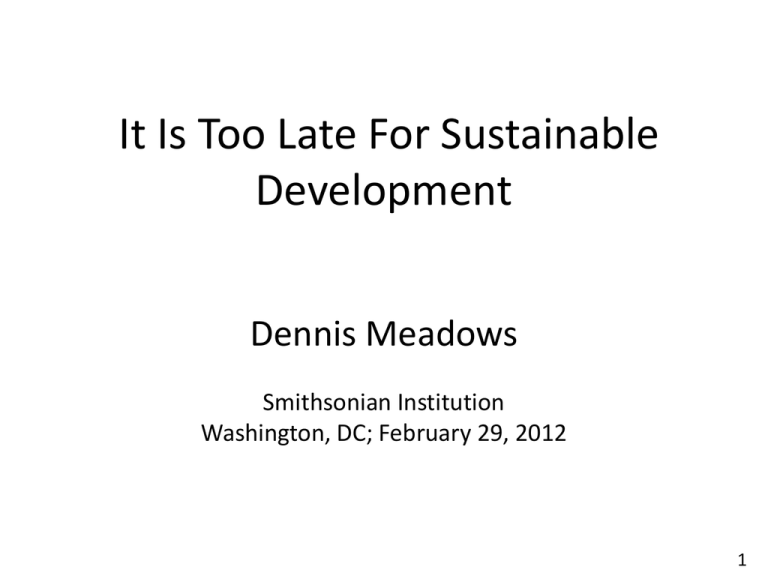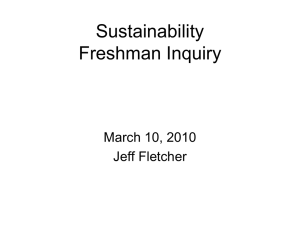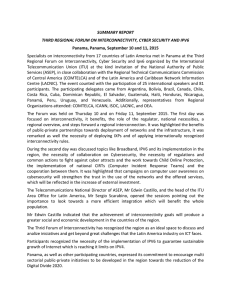Here - Smithsonian Institution
advertisement

It Is Too Late For Sustainable Development Dennis Meadows Smithsonian Institution Washington, DC; February 29, 2012 1 Goals for This Session • I will briefly describe what we did in 1970 – 1972 and summarize the main contributions of our study. • Then I will describe five reasons it is too late to achieve sustainable development. – Public discourse has difficulty with subtle, conditional messages . – Growth advocates change the justification for their paradigm rather than changing the paradigm itself. – The global system is now far above its carrying capacity. – We act as if technological change can substitute for social change. – The time horizon of our current system is too short. • As a result, I will suggest that it is essential now to put more emphasis on raising the resilience of the system. 2 What We Did A team of 16 people worked under my direction to elaborate a computer model representing the causes and consequences of growth in the main physical factors characterizing global development over the period 1900 – 2100. The model was first conceived by Jay Forrester, who described it in his book, World Dynamics. My team wrote and published 3 additional books on the project, The Limits to Growth, Toward Global Equilibrium, and Dynamics of Growth in a Finite World. Our focus was on: Population Nonrenewable resources Industrial goods Persistent pollution Food 3 Our Main Contributions • We did NOT prove that there are limits to physical growth on a finite planet. We assumed it. • We did present information about a variety of physical limits- water, soils, metals, and other resources – in order to make the idea of limits plausible. 4 Our Main Contributions • We described the reasons growth of population and industrial output is inherently exponential. • We showed that exponential growth quickly rises to any conceivable limit. • Our computer scenarios demonstrated that prevailing growth policies will lead to overshoot and collapse, not asymptotic approach to limits. • We suggested that changes in the policies could lead to a sustainable state, if the changes dealt with both cultural and technical issues and were implemented soon. 5 Public discourse has difficulty with subtle, conditional messages 6 The Limits to Growth presented 12 scenarios. Four of them showed a relatively attractive global equilibrium without any collapse. However, it was written in the New York Times: “It is no coincidence that all the simulations based on the Meadows world model invariably end in collapse” The Limits to Growth, Peter Passell, Marc Roberts, and Leonard Ross, New York Times, April 2, 1972 7 We said: “These graphs are not exact predictions of the values of the variables at any particular year in the future. They are indications of the system’s behavioral tendencies only.” P. 93, The Limits to Growth However a Google today search on “the Club of Rome predicted” yields 13,700 hits, for example: “In 1972 Limits to Growth, published by the Club of Rome, predicted that the world will run out of gold in 1981, mercury in 1985, tin by 1987, zinc by 1990, petroleum by 1992, and copper, lead and natural gas by 1993” 8 Growth advocates change the justification for their paradigm rather than changing the paradigm itself. 9 At every single stage – from its biased arrival to its biased encoding, to organizing it around false logic, to misremembering and then misrepresenting it to others, the mind continually acts to distort information flow in favor of the usual good goal of appearing better than one really is Page 139, in The Folly of Fools; The Logic of Deceit and Self-Deception in Human Life, Robert Trivers, Basic Books, New York, NY 2011 10 Evolution of the Criticisms 1970s: There are no effective limits. 1980s: There are limits, but they are far away. 1990s: The limits are near, but technology and markets can evade them easily. 2000s: Technology and markets do not always evade the limits, but the best policy is still to pursue GNP growth, so we will have more resources to solve problems. 2010s: If we had been able to sustain economic growth, we would not have had trouble with the limits. 11 Given enough energy, minerals might be reclaimed from under the sea, or from seawater itself. A virtually infinite source of energy, the controlled nuclear fusion of hydrogen, will probably be tapped within 50 years. “The Limits to Growth”, by Peter Passell, Marc Roberts and Leonard Ross, New York Times, April 2, 1972. 12 “natural resources are not finite in any meaningful economic sense, mind-boggling though this assertion may be. The stocks of them are not fixed but rather are expanding through human ingenuity.” p. 24, Julian L. Simon, The Ultimate Resource2, Princeton University Press, Princeton, NJ, 1996 13 We are following the collapse scenario From: Growing within Limits, Netherlands Environmental Assessment Agency, October 2009, page 23. 14 The global system is now far above its carrying capacity 15 GEI Global Ecological Footprint: 1965 - 2007 1972 1965 2007 Year 16 17 18 Comparison of the Equilibrium and Standard Scenarios; 2012 & 2020 Eq/Std 2012 Eq/Std 2020 Resources Population Pollution Food/Capita Ind./Capita 19 We act as if technological change can substitute for social change. 20 21 Four Factors Determine the Amount of CO2 Emissions from Fossil Fuel Use Social Factors Technical Factors 22 Introductory Thought Experiment • I am addicted to shopping. I have filled my house up with enormous piles of stuff. There are also piles of trash from all the wrappings. • I no longer have room to move around comfortably in the space of my own home. This is NOT sustainable! • I have just acquired a wonderful piece of technology – a hammer. • Can the hammer alone give me a sustainable living space? 23 Of Course Not! I Would Also Need: • GOALS: to create living space in my house and the ability to spend time achieving that goal. • MATERIALS: to build the new storage units. • EXPERTISE: to design them. • TOOLS: such as saws, tape measure, pencil. • MONEY to buy the materials and hire help. • TIME and SKILLS to construct the new units and organize my stuff in them. If any one of those elements is missing, the hammer does not solve my problem. And if I continue buying more and more stuff. Even excellent shelves will not solve the problem. 24 Avoiding collapse will require a longer time horizon than our current system provides. 25 The Easy Oil is Gone • Oil discoveries peaked in 1960s. • Every year since 1984 oil consumption has exceeded oil discovery. • In 2009 discoveries were about 5 billion barrels (bb); consumption was about 31 bb. • Of the world’s 20 largest oil fields, 18 were discovered 1917 - 1968; 2 in the 1970s; 0 since 26 Global Oil Production is Nearing the End of its Plateau • 1995 - 1999 • 2000 - 2004 • 2005 - 2009 + 5.5% + 7.9 % + 0.4 % - data from the International Statistical Supplement – 2010 edition, International Energy Agency, p. 18 • 2010 - 2030 – 50%* * Projection from Crude Oil – The Supply Outlook, Energy Watch Group, Feb 2008, p. 12. 27 There is Growing Awareness that the Oil Peak Has Passed “By 2012, surplus oil production capacity could entirely disappear, and as early as 2015, the shortfall in output could reach nearly 10 MBD.” - U S Joint Forces Command, Joint Operating Environment Report, February, 2010 “Peak Oil Production May Already be Here,” - Science, p. 1510, Vol 331, March 25, 2011 28 Oil Price Signals the Decline 29 Easy Problems Better -------> Action #1 Desired Actual Action #2 Now Next Evaluation Future 30 Difficult Problems Action #1 Better -------> Action #2 Desired Actual Now Next Evaluation Future 31 It is essential now to put more emphasis on raising the resilience of the system 32 Sustainability Diversity and Interconnectivity 33 Sustainability More Efficient Diversity and Interconnectivity 34 Sustainability Diversity and Interconnectivity 35 Sustainability More Resilient Less Efficient Diversity and Interconnectivity 36 It is essential now to start changing our behavior 37











